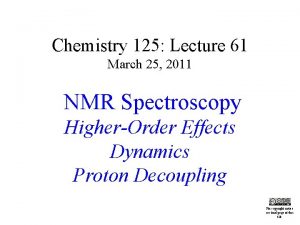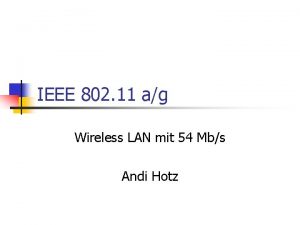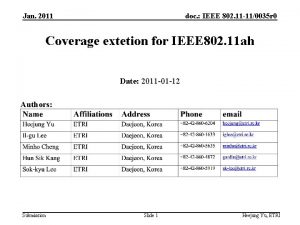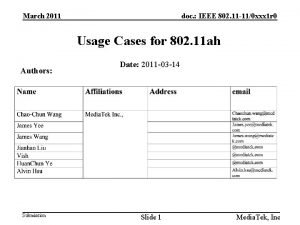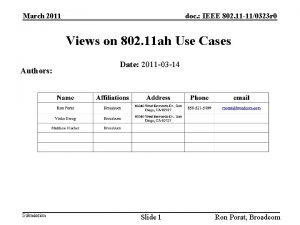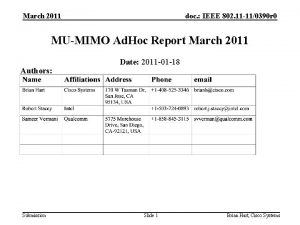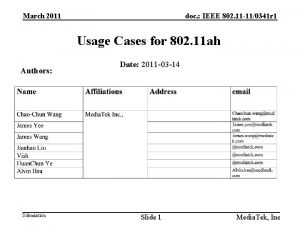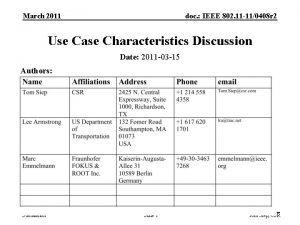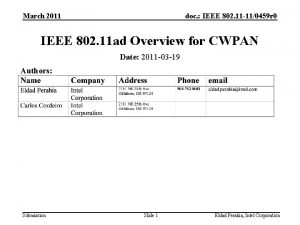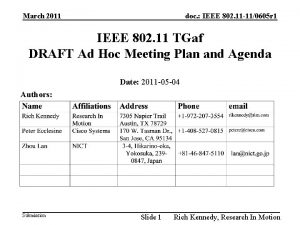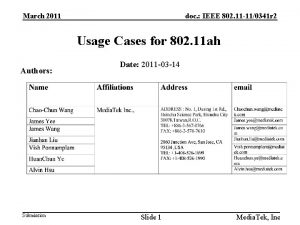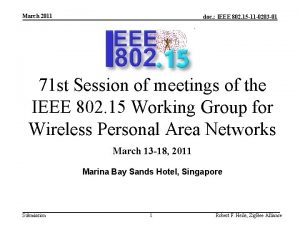March 2011 doc IEEE 802 19 110035 r













- Slides: 13

March 2011 doc. : IEEE 802. 19 -11/0035 r 0 Update on European/UK Regulatory situation on cognitive access in the White Spaces Andy Gowans/Mika Kasslin/Rich Kennedy March 2011 Submission

March 2011 doc. : IEEE 802. 19 -11/0035 r 0 Overview • Where we are in the Europe/UK • Update on Conclusions so far in Europe/UK • Next steps towards implementation Submission 1

March 2011 doc. : IEEE 802. 19 -11/0035 r 0 The story so far in Europe • European Commission – – • CEPT/ECC – – – • RSPG published Report and subsequent Opinion on Cognitive Radio (includes sections on White spaces in the Broadcast bands) for more info see http: //rspg. groups. eu. int/_documents/meeting/rspg 24/rspg_10_348_ct_opinion_final. pdf This may lead to further work being proposed by the European Commission to be taken through the Radio Spectrum Committee. ECO have published ECC Report 159 –Cognitive radio systems in the “white spaces” in 470 790 MHz which was completed in the WGSE PT 43. See http: //www. erodocdb. dk/doks/doccategory. ECC. aspx? doccatid=4 WGFM have set up a correspondence group to work on frequency management activities for cognitive radio send mail to : listserv@list. ero. dk? Subject=Subscribe CG_CRS. WGRA have set up a correspondence group to work on regulatory and enforcement issues in relation to cognitive access to “white spaces” in 470 – 790 MHz send mail to : listserv@list. ero. dk? Subject=Subscribe%20 WS_CR ETSI – – ETSI Technical Committee on Reconfigurable Radio Systems (TC-RRS) have started work items looking at system requirements documents etc. for white spaces. TC-BRAN may also have an interest in this area in the future also. Submission 2

March 2011 doc. : IEEE 802. 19 -11/0035 r 0 The story so far in UK • OFCOM consultations so far : – Digital Dividend – cognitive access – Feb to May 2009 – see http: //stakeholders. ofcom. org. uk/consultations/cognitive/? a=0 – Digital Dividend – Geolocation for Cognitive Access – Nov 2009 – Feb 2010 http: //stakeholders. ofcom. org. uk/consultations/cogaccess/ – Implementing Geolocation - Nov 2010 to Date – see http: //stakeholders. ofcom. org. uk/consultations/geolocation/ still collating responses but expect to send out a response soon • OFCOM also co-ordinating activities with: – Regulatory work in EC and CEPT/ECC – Standards activities in ETSI, IEEE 802, IETF Paws Submission 3

March 2011 doc. : IEEE 802. 19 -11/0035 r 0 ECC Report 159 Covered • Assumptions on WSD characteristics • Protection of Broadcasting Service • Protection of PMSE systems • Protection of Radio Astronomy Service (608 -614 MHz) • Protection of ARNS (645 -790 MHz) • Protection of Mobile/Fixed Services in adjacent bands • Requirements to WSDs under Geo-location control • Estimated amount of White Space spectrum Submission

March 2011 doc. : IEEE 802. 19 -11/0035 r 0 Overview • Where we are in the Europe/UK • Update on Conclusions so far in Europe/UK • Next steps towards implementation Submission 5

March 2011 doc. : IEEE 802. 19 -11/0035 r 0 Conclusions So Far – ECC Report 159 • Conclusions on Broadcast Service protection – – • Conclusions on PMSE protection – – • Spectrum sensing, if employed by a stand-alone WSD (autonomous operation) is not reliable enough to guarantee protection of nearby DTT receivers. However, a collaborative sensing may help. Operation of a WSD assisted by a geo-location database is currently the most feasible option Geo-location database would provide a WSD with information on the available frequencies and the associated maximum power values that the WSD is permitted to use Is left to administrations to decide whether to set or not fixed maximum permitted power limits for WSDs Spectrum sensing appears to be problematic Geo-location database appears to be the most feasible approach • Practical questions related to registration of PMSE data • Different PMSE regulatory regimes across CEPT countries Disable beacon approach may provide a “bubble of protection” in locations where PMSE equipment is in use but no practical solutions proposed as yet. National or area specific safe-harbour channels not used by DTT and reserved for PMSE use seem a good idea to cover casual or temporary unregistered use. General Conclusions – – Still more work to be done on suitable protection for ARNS and Fixed/Mobile bands in adjacent bands (below 470 MHz and above 790 MHz). Basis for the principles and requirements for operation of WSDs under the geo-location database have been proposed Information to be exchanged between a WSD and a geo-location database have been identified and proposed Administrations should have flexibility to adopt the geo-location framework suitable for their national circumstances Submission 6

March 2011 doc. : IEEE 802. 19 -11/0035 r 0 Overview • Where we are in the Europe/UK • Update on Conclusions so far in Europe/UK • What do we need to look at going forward with a view towards implementation Submission 7

March 2011 doc. : IEEE 802. 19 -11/0035 r 0 National versus International issues • Usage varies across many European countries – Degree of protection for DTV (eg indoors / outdoors) – Whether PMSE usage is registered • Regulators likely to have a different bias between protection of incumbents and facilitation of innovative new services • Usage models for cognitive may differ – Rural broadband may be more important in some countries – Degree of eg Wi. Fi coverage differs • Need a framework that allows the same device to be used throughout Europe (and ideally the world) enabling roaming, economies of scale, etc • Need to optimise the balance between harmonisation and ability to tailor to national circumstances Submission 8

March 2011 doc. : IEEE 802. 19 -11/0035 r 0 Ofcom viewpoint Harmonise • • Leave to national regulators • • Database addresses (so a device knows who to contact) Format of information sent from the device Format of information received by the device Conformance Standard for declaring conformity with the R&TTE Directive • – – • Submission Means of populating the database Number of databases, ownership, geographical extent Parameters used to populate database 9 Propagation models Building penetration losses Required C/I ratios for devices Required locational accuracy and use of that information Everything else!

March 2011 Section 2 doc. : IEEE 802. 19 -11/0035 r 0 WHAT? European harmonised conformance standard ECC Report 159 and Ofcom Consultation give some examples of the data elements that regulators would like to see exchanged between database and the WSD. But WSD manufacturer’s are only responsible for ensuring compliance with the R&TTE Directive, so what about guidance on conformance? This normally means compliance with a European Harmonised Standard written by ETSI. The HS will need to include the master set of European regulators requirements! HS as a minimum should include conformance tests to assess : • frequency accuracy • location information provided by WSD • location accuracy provided by WSD • WSD maximum Transmit EIRP/power level given by the database • WSD ACLR values/spectrum mask • Spurious emission levels (both Tx and Rx) • Validation request periodicity Could also include conformance tests to assess: • Extra requirements for allowing dispensations for Master or slave devices • can the overall accuracy of the measurements of the master and slave locations can be combined into a single overall accuracy for a coverage area? How do we asses this? • Extra requirements for allowing dispensations for Fixed or mobile use? • how to do test taking into account an antenna or not? Submission

March 2011 11 Section 2 doc. : IEEE 802. 19 -11/0035 r 0 Some of the Big Issues/ Questions? ECC Report 159 and Ofcom Consultation give some examples of the data elements that regulators would like to see exchanged between database and the WSD. But WSD may have to differentiate between different national requirements (i. e. as they may only need to provide or act on a sub set of the full data set from the HS). So how complicated do we want these requirements to be? Big issues - Questions : • Does the database need to differentiate between Fixed and Mobile? • Does the database or the standard need to differentiate between Master and Slave WSD? • Do we need to set the a maximum power level related to type of usage? • Should we allow for a Manual interface to enable the user to provide limited extra information (e. g. Antenna details, fixed/mobile or indoor/outdoor usage) • What use is a device identifier if it is not linked to an assumption (e. g. ACLR value)? • How de we deal with the geo-location accuracy problem? Submission

March 2011 12 Section 2 doc. : IEEE 802. 19 -11/0035 r 0 Some of the Big Issues/ Questions? Timescales going forward. Big issues - Questions : • How long to get to stable ETSI harmonised Standard? (12 -18 Month ? ) • How long before PMSE and other adjacent band technical requirements will be finalised? (6 -12 month? ) • When will any of the European administrations have a regulatory environment for database in place? • Will the EC issue any mandates/spectrum decision in order to facilitate use of Broadcast “white spaces in EU member states? Will there be an CEPT/ECC deliverable on spectrum usage for Broadcast “white spaces”? Submission












